Untitled

Farmers use these to prevent creekbank erosion. In a short time, a high volume of cattle can sog up a landscape, creating giant unwanted puddles and even choke waterways as they drink and cool off. They are made of coconut hair and jute.

Farmers use these to prevent creekbank erosion. In a short time, a high volume of cattle can sog up a landscape, creating giant unwanted puddles and even choke waterways as they drink and cool off. They are made of coconut hair and jute.
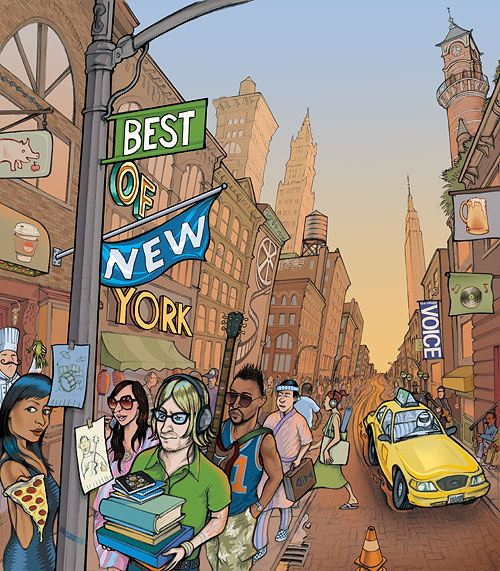
I’ve justed turned in this illo which will be promoting the Village Voice’s ‘Best of New York’ issue which comes out in October. My main concern at the moment is whether the lower portion of the art is printing too dark – darker and more saturated than on my monitor anyway… I may have to tweak that. The architecture is mostly a blend of Chinatown, Soho, Lower east side, the East and West Village. Here’s a few details:
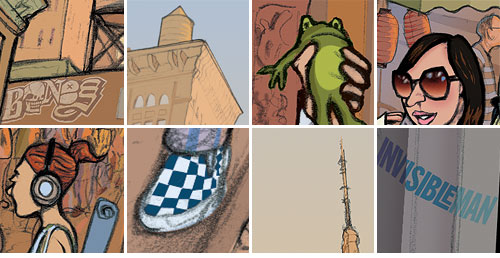
Recently I took my mini-Moleskin sketchbook on a sketching “expedition” to Fort Greene Park. My goal was to hunt out potential locations or views for future paintings. Not too much time was spent on any of these, just enough to get layout ideas and general composition possibilities. No color notes were taken.
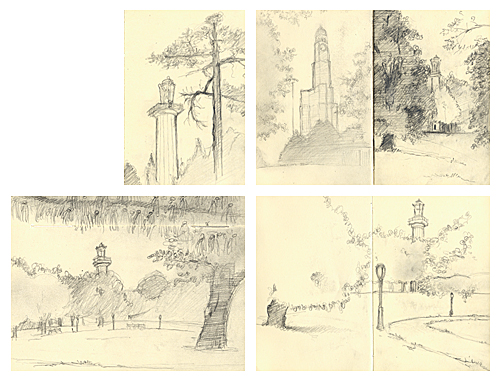
Outta the bunch I have already selected one and begun a painting. I will post progress on that soon.
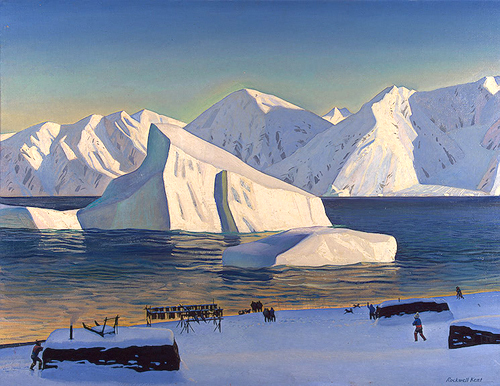
Early November: North Greenland – Rockwell Kent 1933
Just got back from a breathtakingly beautiful vacation up in Boothbay Harbor, Maine. One of the suprise highlights was a quick stop in at the beautiful Portland Museum of Art, where I was delighted to find a huge Rockwell Kent exhibit. I don’t know if it was all the salt in the water that I swam in or too many lobster rolls, but this show just floored me.
The first images that come to my mind when I hear Kent’s name are the amazing black and white ink drawings of Moby Dick. I had always kept him firmly in the camp of the great American pen and ink illustrators of the early 20th century. This show completely enlarged my view of his work, and of his amazing life. This fellow was a grade-A swashbuckler, travelling to the world’s most spectacularly desolate and awe-inspiring places, and surviving any shipwrecks that nature threw his way (at least one that I am aware of).
His glowing landscpaes of Monhegan Maine, Tierra del Fuego, Greenland and Alaska are meant to remove the viewer’s self-consciousness, and just revel in the marvel of the scene. He was quite a modernist as well, producing playfully cartoonish shapes, yet preserving their deep cobalt blue glow and blindingly bright snowfields.
I’m looking forward to reading his wild tales of adventure as he sails to Tierra del Fuego in his book Voyaging. If you happen to be up in the area near Portland, ME be sure to check this show out. It runs until October 16th.
Amazon: Rockwell Kent: The Mythic and the Modern
Amazon: Voyaging
Link: Portland Museum of Art
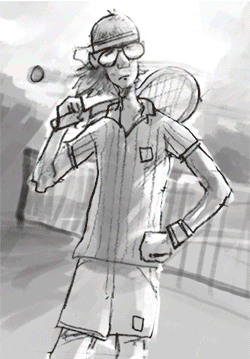 I’m working on this illustration right now, and I though I’d show a few frames of how it is evolving. I always loved reading Step by Step Graphics magazine, and I feel that tutorials are really one of the best ways to learn. I plan on doing some more in-depth tutorial stuff in the near future….I’ll update this animated gif with a new frame when I complete it, which should be very soon…
I’m working on this illustration right now, and I though I’d show a few frames of how it is evolving. I always loved reading Step by Step Graphics magazine, and I feel that tutorials are really one of the best ways to learn. I plan on doing some more in-depth tutorial stuff in the near future….I’ll update this animated gif with a new frame when I complete it, which should be very soon…
In other news, The Lambkins, (my first book cover) is now on store shelves.
UPDATE: I have added the final frame.

Recent sketching from the subway, on an airplane, east river park and robert moses beach.
 I found this guide to reproduction online a few years ago, and I was glad to see that it’s authors have kept it up to date. Written by Ron Rege Jr, Dave Choe, Brian Ralph and Jordan Crane, this handy guide is described as “A Primer on Xerography, Silkscreening and Offset Printing”.
I found this guide to reproduction online a few years ago, and I was glad to see that it’s authors have kept it up to date. Written by Ron Rege Jr, Dave Choe, Brian Ralph and Jordan Crane, this handy guide is described as “A Primer on Xerography, Silkscreening and Offset Printing”.
Print this out and keep it in your studio, as it will come in very handy one day. It has a great listing of specific brands of materials they recommend for each type of reproduction as well as where to order them from. I am gearing up for a super-secret Invisibleman project involving one of the aforementioned forms of reproduction, and no doubt this guide will be referred to frequently!
Link: Re: A Guide to Reproduction (PDF) 3.7mb